ADJACENT ANGLES
Subscribe to our ▶️ YouTube channel 🔴 for the latest videos, updates, and tips.
Two angles are adjacent if they have a common vertex and a common side.
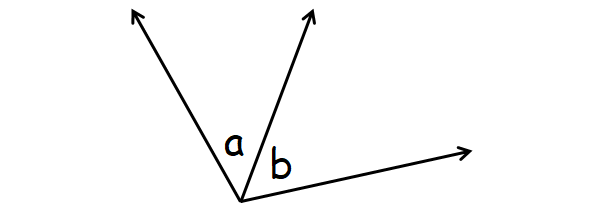
In the diagram below, the two angles a and b are adjacent.
Solved Examples
Examples 1-2 : Identify the two pairs of adjacent angles in the given figure.
Example 1 :
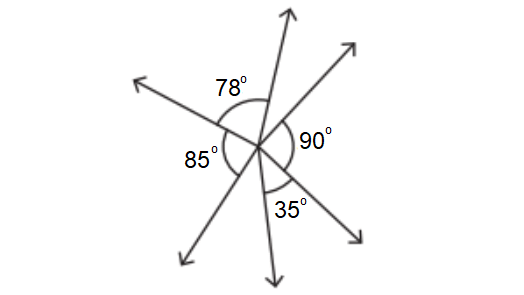
Solution :
78° and 85°
35° and 90°
Example 2 :
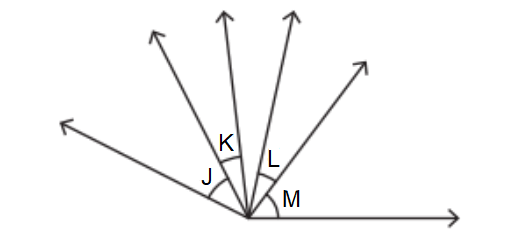
Solution :
∠J and ∠K
∠L and ∠M
Example 3 :
In the figure given below, if ∠ABC is a right angle, find the value of x.
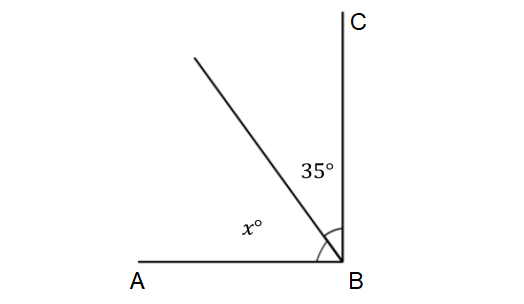
Solution :
In the figure above, x° and 35° are adjacent angles and they add up to m∠ABC.
x° + 35° = m∠ABC
Since ∠ABC is a right angle, substitute m∠ABC = 90°.
x° + 35° = 90°
Subtract 35° from both sides.
(x° + 35°) - 35° = 90° - 35°
x° + 35° - 35° = 55°
x° + 0° = 55°
x° = 55°
The value of x is 65.
Example 4 :
In the figure given below, if ∠XYZ is a right angle, find the value of x.
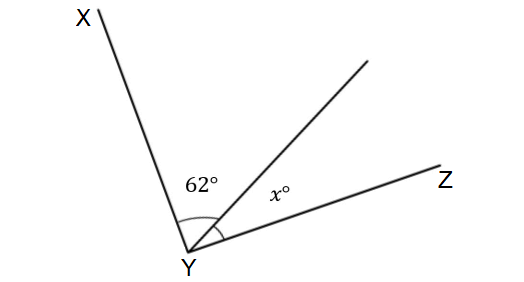
Solution :
In the figure above, x° and 62° are adjacent angles and they add up to m∠XYZ.
x° + 62° = m∠XYZ
Since ∠XYZ is a right angle, substitute m∠XYZ = 90°.
x° + 62° = 90°
Subtract 62° from both sides.
(x° + 62°) - 62° = 90° - 62°
x° + 62° - 62° = 28°
x° + 0° = 28°
x° = 28°
The value of x is 28.
Example 5 :
In the figure given below, if ∠PQR is a straight angle, find the value of x.
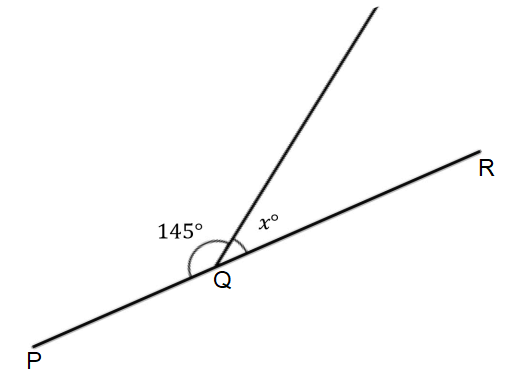
Solution :
In the figure above, 145° and x° are adjacent angles and they add up to m∠PQR.
145° + x° = m∠PQR
Since ∠PQR is a straight angle, substitute m∠PQR = 180°.
145° + x° = 180°
Subtract 145° from both sides.
(145° + x°) - 145° = 180° - 145°
145° + x° - 145° = 35°
x° = 35°
The value of x is 35.
Example 6 :
In the figure given below, if ∠JKL is a straight angle, find the value of x.
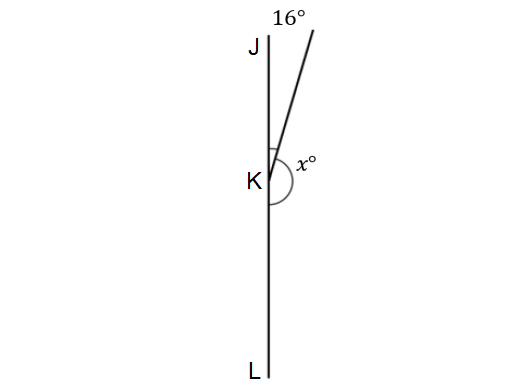
Solution :
In the figure above, x° and 16° are adjacent angles and they add up to m∠JKL.
x° + 16° = m∠JKL
Since ∠JKL is a straight angle, substitute m∠JKL = 180°.
x° + 16° = 180°
Subtract 16° from both sides.
(x° + 16°) - 16° = 180° - 16°
x° + 16° - 16° = 164°
x° + 0° = 164°
The value of x is 164.
Example 7 :
In the figure given below, if ∠ABC is a straight angle, find the value of x.
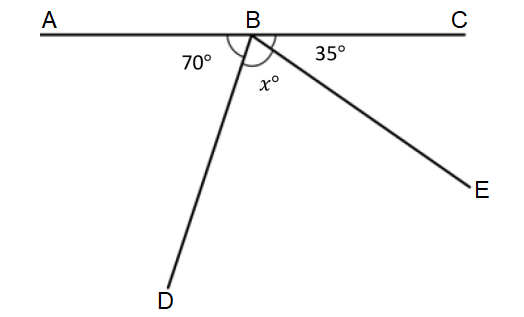
Solution :
In the figure above, ∠ABD and ∠DBC are adjacent angles and they add up to m∠ABC.
m∠ABD + m∠DBC = m∠ABC
Since ∠ABC is a straight angle, substitute m∠ABC = 180°.
m∠ABD + m∠DBC = 180°
m∠ABD + m∠DBE + m∠EBC = 180°
Substitute m∠ABD = 70°, m∠DBE = x° and m∠EBC = 35°.
70° + x° + 35° = 180°
x° + 105° = 180°
Subtract 105° from both sides.
(x° + 105°) - 105° = 180° - 105°
x° + 105° - 105° = 75°
x° + 0° = 75°
x° = 75°
The value of x is 75.
Example 8 :
In the figure given below, if ∠PQR is a straight angle, find the value of x.
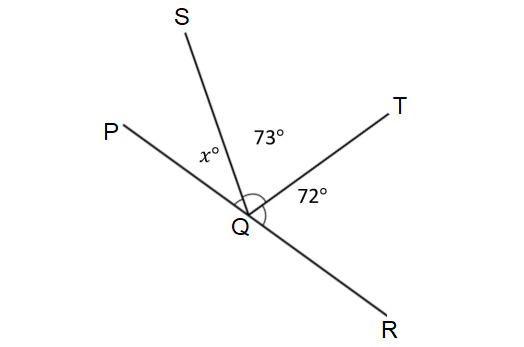
Solution :
In the figure above, ∠PQT and ∠TQR are adjacent angles and they add up to m∠PQR.
m∠PQT + m∠TQR = m∠PQR
Since ∠PQR is a straight angle, substitute m∠PQR = 180°.
m∠PQT + m∠TQR = 180°
m∠PQS + m∠SQT + m∠TQR = 180°
Substitute m∠PQS = x°, m∠SQT = 73° and m∠TQR = 72°.
x° + 73° + 72° = 180°
x° + 145° = 180°
Subtract 145° from both sides.
(x° + 145°) - 145° = 180° - 145°
x° + 145° - 145° = 35°
x° + 0° = 35°
x° = 35°
The value of x is 35.
Example 9 :
In the figure shown below, PQST is a rectangle. Without using a protractor, determine m∠SQT.
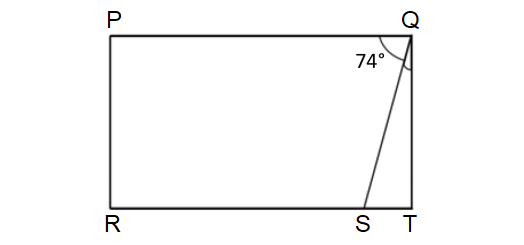
Solution :
In the figure above, ∠PQS and ∠SQT are adjacent angles and they add up to m∠PQT.
m∠PQS + m∠SQT = m∠PQT
Since PQST is a rectangle, each interior angle is a right angle. Then, m∠PQT = 90°.
m∠PQS + m∠SQT = 90°
Substitute m∠PQS = 74°.
74° + m∠SQT = 90°
Subtract 74° from both sides.
74° + m∠SQT - 74° = 90° - 74°
m∠SQT = 16°
Example 10 :
Two adjacent angles are complementary. If the second angle is 10° more than three times the first angle, find the two angles.
Solution :
Let x° be the first angle.
Then, the second angle is (3x° + 10°).
Since the two adjacent angles are complementary,
x° + (3x° + 10°) = 90°
x + 3x + 10 = 90
4x + 10 = 90
Subtract 10 from both sides.
(4x + 10) - 10 = 90 - 10
4x + 10 - 10 = 80
4x + 0 = 80
4x = 80
Divide both sides by 4.
x = 20
3x + 10 = 3(20) + 10
= 60 + 10
= 70
Therefore, the required angles are 20° and 70°.
Subscribe to our ▶️ YouTube channel 🔴 for the latest videos, updates, and tips.
Kindly mail your feedback to v4formath@gmail.com
We always appreciate your feedback.
About Us | Contact Us | Privacy Policy
©All rights reserved. onlinemath4all.com

Recent Articles
-
US Common Core K-12 Curricum Algebra Solving Simple Equations
Jan 06, 26 04:54 AM
US Common Core K-12 Curricum Algebra Solving Simple Equations -
10 Hard SAT Math Questions (Part - 4)
Jan 05, 26 06:56 PM
10 Hard SAT Math Questions (Part - 4) -
10 Hard SAT Math Questions (Part - 3)
Jan 05, 26 06:34 PM
10 Hard SAT Math Questions (Part - 3)

